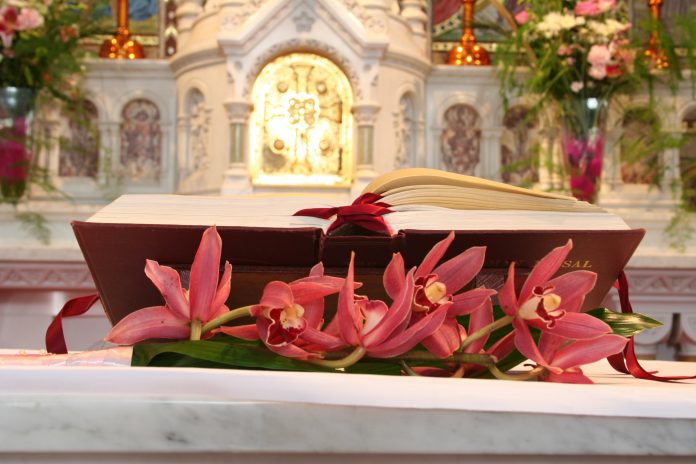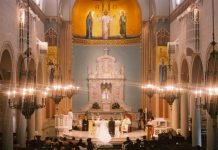
by Jem Sullivan, Ph.D.
As the Church in the United States prepares to implement the Roman Missal Third Edition, the Eucharist leads catechists to reflect on the many ways in which they will contribute to this vital moment in the Church’s life. Catechists might ask: How is liturgical catechesis, or mystagogy, to be shaped by the revised Roman Missal? Let’s reflect on this question.
Mystagogical catechesis flows from the nature of the liturgy.
In the midst of liturgical changes, there is much in the Mass that remains unchanged. Continuity in the midst of change draws us ever deeper into the nature of the liturgy itself.
The beauty of every Eucharist flows first from the Incarnation, the central mystery of Christian faith. Christ is, as St. Paul writes, “the image (eikon) of the invisible God” (Colossians 1:15). Once the invisible God became visible in Jesus Christ, God’s relationship to humanity, and humanity’s relationship to creation, was radically changed. Now, matter really matters. For this reason, mystagogical catechesis moves from visible and concrete liturgical signs and symbols to the invisible presence and love of God.
Created as a unity of mind, body, and spirit, we express and perceive spiritual realities through physical signs and symbols. Sacramental celebrations are “woven from signs and symbols… [whose] meaning is rooted in the work of creation and in human culture, specified by the events of the Old Covenant and fully revealed in the person and work of Christ” (Catechism of the Catholic Church, nos. 1145–1147).
In the liturgy, signs from human social interaction also become the privileged means by which God comes to us: “washing and anointing, breaking bread and sharing the cup can express the sanctifying presence of God and man’s gratitude toward his Creator” (CCC, nos. 1145-1147). Mystagogical catechesis weaves together these liturgical signs, biblical images, and sacramental realities.
Liturgical catechesis on the revised Roman Missal also highlights the beauty of the Eucharist that flows from the nature of the liturgy itself. So whether Mass is celebrated in a majestic basilica cathedral, in a familiar parish church, or in a stark prison cell, its beauty radiates from the sacred action itself. For “the Church celebrates in the liturgy above all the Paschal mystery by which Christ accomplished the work of our salvation” (CCC, n. 1067).
The word liturgy evokes the “participation of the People of God in the work of God.” But what is the “work of God” in which the faithful are invited to participate at every Eucharist? It is nothing less than the saving work of “Christ, our redeemer and high priest, [who] continues the work of our redemption in, with, and through his Church” (CCC, n. 1069).
Practical Approaches
As catechists and teachers, consider these practical approaches that can contribute to the implementation of the revised Roman Missal:
* The “best catechesis on the Eucharist is the Eucharist itself, celebrated well” (Sacramentum Caritatis, n. 64). Focus mystagogical catechesis on the beauty of the Mass and the presence of the Lord who desires our friendship. Liturgy is the public prayer of the Church. Understanding and appropriating the liturgical changes becomes a renewed opportunity to enter more fully and more deeply into the Church’s public prayer.
* For two thousand years the Mass has been received in faith as the privileged “source and summit” of the Church’s life. Celebrate this continuity in the midst of liturgical changes and the rich diversity of liturgical traditions.
* Invite reflection on the biblical roots of the Mass and liturgical responses, gestures, and ritual actions. Connect word and Sacrament so that the faithful better understand and appropriate liturgical changes through listening to and living by God’s Word.
* Focus on the communal aspect of appropriating liturgical changes as an expression of belonging to a living community of faith.
* Emphasize an integrated mystagogical catechesis wherein the liturgy is understood as both the redemptive work of Christ and the work of the people, and as both a communal meal and saving sacrifice.
Finally, take the opportunity to share your personal witness to the life-transforming power of encountering Christ in the Eucharist.
Jem Sullivan, Ph.D., is staff to the Secretariat of Evangelization and Catechesis at the United States Conference of Catholic Bishops.
Copyright 2011, Bayard, Inc. All rights reserved. This article is protected by United States copyright and other intellectual property laws and may not be reproduced, rewritten, distributed, redisseminated, transmitted, displayed, published or broadcast, directly or indirectly, in any medium without the prior written permission of Bayard, Inc.
This article was written by the Catechist Staff and appeared in Catechist magazine, March 2011.
Image Credit: Shutter Stock 2510744




